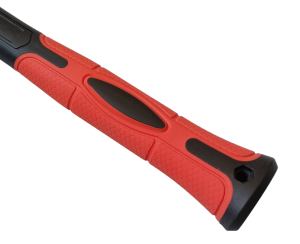The claw hammer is an indispensable tool for every handyman. With its dual functionality of driving nails and removing them, it serves multiple uses in various projects. In this article, we'll explore the various uses of the claw hammer, the types available, and why it's a must-have in your toolbox. Whether you're into DIY projects or professional carpentry, understanding the versatility of this tool can make your life easier.
What Is a Claw Hammer?
A claw hammer is a type of hammer featuring a metal head with two distinct sides: one side is the flat head used to drive nails, and the other is the claw used to remove nails. The claw is typically curved, forming a V-shaped indentation that grips the nail head for efficient extraction. This versatile tool is essential for tasks involving wood and other materials.

Types of Claw Hammers
When choosing a claw hammer, it's important to understand the different types available:
Curved Claw Hammer
The curved claw hammer features a deeply curved claw. This design provides excellent leverage when removing nails, making it ideal for general carpentry and woodworking tasks.
Straight Claw (Rip) Hammer
Straight claw hammers, also known as rip claw hammers, have a claw that is almost straight. This type of claw hammer is better suited for demolition tasks, such as prying apart wooden structures or removing drywall.
Framing Hammer
A framing hammer is a heavier version, often weighing around 20 ounces or more. It's designed for heavy-duty construction work, like framing houses.
How Is a Claw Hammer Used?
Using a claw hammer involves two primary functions:
-
Driving Nails: Position the nail against the material, hold it steady, and use the hammer to strike the nail head until it's embedded.
-
Removing Nails: Slide the claw portion of the hammer under the embedded nail's head, and pry it out using leverage.
Common Uses of the Claw Hammer
The claw hammer is a staple in many toolkits due to its multiple uses:
- Driving and Pulling Nails: Its main use is hammering in and removing nails from various materials, including wood and thin metal.
- Demolition Tasks: The hammer's claw can also be used to pry apart materials during light-duty demolition.
- Carpentry and Woodworking: Ideal for home improvement projects and professional carpentry work.
- DIY Projects: Whether hanging pictures or building furniture, the claw hammer is essential for handyman tasks.
How to Use the Claw to Remove Nails
One of the primary uses of the claw is nail removal. Here's how to do it effectively:
- Position the Claw: Place the V-shaped claw under the nail head.
- Apply Leverage: Gently rock the hammer to grip the nail firmly.
- Pry the Nail Out: Use the curved claw as a fulcrum to pry the nail out smoothly.
This method ensures minimal damage to the surrounding material.
Demolition Tasks with a Claw Hammer
The claw hammer isn't just for nails—it can handle demolition tasks too:
- Removing Drywall: Use the hammer's flat face to punch through drywall and the claw to pull it down.
- Dismantling Structures: The straight claw is perfect for tearing apart wooden structures.
- Prying Materials: The hammer can pry apart loose or rotten boards during repairs.
Remember, for more extensive demolition, consider a heavier tool like a sledgehammer.
Woodworking and Carpentry Applications
In woodworking and carpentry, the claw hammer is indispensable:
- Assembling Projects: Drive nails to join pieces of wood.
- Adjusting Fits: Tap pieces into place without damaging them.
- Removing Mistakes: Easily remove nails if adjustments are needed.
For professional results, choose a hammer with a smooth or textured face to suit your preference.
Choosing the Best Claw Hammer
Selecting the right claw hammer depends on your specific needs:
- Weight: A hammer that weighs about 16 ounces is versatile for most tasks.
- Handle Material:
- Wooden Handles: Classic feel, absorbs shock but can break over time.
- Fiberglass Handles: Durable, heavy-duty, and resist vibrations.
- Face Type:
- Smooth Face: Prevents surface damage; ideal for finish work.
- Textured Surface: Reduces slipping when striking nails.
An ergonomic grip and balanced design enhance comfort and efficiency.
Safety Tips When Using a Claw Hammer
Safety should always be a priority:
- Wear Protection: Use safety glasses to protect your eyes from flying debris.
- Secure Your Materials: Ensure the workpiece is stable.
- Check the Hammer: Inspect for cracks in the handle or looseness in the hammerhead.
- Use Proper Technique: Swing with controlled motions to avoid missing the nail head.
By following these tips, you reduce the risk of accidents and improve your work quality.
Contact Us for Quality Claw Hammers
Looking for reliable tools? Contact us at JTW Tools. We specialize in high-quality hammers with forged steel heads and ergonomic designs.
Explore our range of Carbon Steel TPR Plastic Handle Hammers.
Our products meet international safety standards, ensuring durability and reliability for all your projects.
Conclusion
The claw hammer is more than just a simple tool—it's a versatile tool essential for driving and pulling nails, performing demolition tasks, and tackling various home improvement projects. By understanding the different types and proper usage, you can enhance your workmanship and efficiency.
Key Takeaways:
- Claw hammers are versatile, suitable for a range of tasks from nailing to demolition.
- Different types of claw hammers like curved and straight claws serve specific purposes.
- Safety is crucial—always use proper techniques and protective gear.
- Choose the right hammer based on weight, handle material, and face texture.
- Contact us at JTW Tools for high-quality, durable hammers to meet your needs.
Empower your projects with the right tools. A quality claw hammer doesn't just make your work easier—it elevates the results. Whether you're a professional or a DIY enthusiast, investing in a good hammer is a decision you won't regret.
Post time: 12-10-2024





